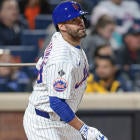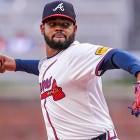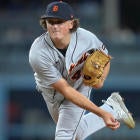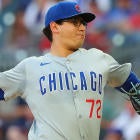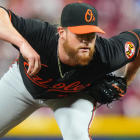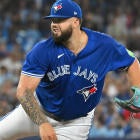Baseball is an odd sport. You need three "outs" for an "in"ning. The defense always has the ball. Managers wear uniforms. The dimensions are different at every stadium. And the fan's halftime is three innings after the game's true halfpoint mark.
Fantasy Baseball is an equally odd endeavor. Nerds that know their numbers are heros. Having the 12th-pick overall is better than having the 11th pick. Catchers, who are involved in every play on the field, are considered afterthoughts many times.
Your Fantasy Draft is bearing down on you like a Fantasy writer on a dozen doughnuts. You will either attack it back -- or you'll end up with remorse for poor decision-making, some stains and eventually it could make you sick to your stomach.
Maybe you should start with an exhibition game first! Check out our new Mock Draft product for free! You can pick where you will draft in a large assortment of different leagues, including 10- or 12-team, Rotisserie or Head-to-Head and even mixed or AL-/NL-only.
Hopefully, this Rotisserie Draft Prep piece will help you avoid the Pepto Bismol after your big day. The following tips are base upon 5x5 12-team mixed leagues.
Pregame Strategy
You want to get in right mindset going into the draft. Have a good idea of which positions are deeper (starting pitching, first base and third base) than others, and which have grown a little shallow (shortstops and relief pitchers). Get some tools at your disposal.|
|
|
| Round | Position |
| 1. | Third base |
| 2. | Outfielder 1 |
| 3. | First base |
| 4. | Outfielder 2 |
| 5. | Second base |
| 6. | Starting pitcher 1 |
| 7. | Outfielder 3 |
| 8. | Catcher 1 |
| 9. | Relief pitcher 1 |
| 10. | Starting pitcher 2 |
| 11. | Shortstop |
| 12. | Starting pitcher 3 |
| 13. | Starting pitcher 4 |
| 14. | Relief pitcher 2 |
| 15. | Outfielder 4 |
| 16. | Corner infielder |
| 17. | Relief pitcher 3 |
| 18. | Outfielder 5 |
| 19. | Starting pitcher 5 |
| 20. | Designated hitter |
| 21. | Catcher 2 |
| 22. | Middle Infielder |
| 23. | Relief pitcher 4 |
- Have a copy of our magazine handy for quick reference to alphabetized player outlooks.
- Print out the Average Draft Values from your league's homepage. These can be invaluable when you are trying to decide when a run might start.
- Print out a set of rankings, or keep a set in a spreadsheet
- Have a copy of a recent mock draft online, so you know where some players have been picked.
- Print out a list of the multi-position eligible players to keep handy.
- Highlight a player or two in the "sleeper" area at each position in your rankings.
- List your picks, from 1-23 (or however many rounds your draft goes), and slot where you think you'll be picking each position. Adjust it as the draft continues. This isn't etched in stone, but it will help you budget how your draft goes. Also, by doing this with a recently finished mock draft, you'll have a good idea of which players will be available at each position in different spots. The table on the right should give you an idea.
Obviously, your first few picks are the ones that can easily sink your ship if you screw those up. These are the ones you want to gamble with the least. The first half of the first round can be interchangeable for the most part, including Alex Rodriguez, Jose B. Reyes, Hanley Ramirez, Jimmy Rollins, David Wright, Albert Pujols, Miguel Cabrera and Johan Santana. It's that back part of the first round that gets tricky. Realizing you have a chance at two of the top 16 picks in the draft, you can strategize accordingly. Ryan Howard and Prince Fielder won't make it to your second pick, and you'll likely have your choice of speedster, with Grady Sizemore and Carl Crawford. If you know the person(s) that your picks are sandwiched around, you might be able to take advantage of their preferences. If you know they are a Phillies fan, you can take Fielder, let them go Howard and another player. You can dictate what happens occasionally.
With early picks, you need to target category winners (Crawford, Reyes and Howard-types) and multi-positional studs (Sizemore, Holliday and Brandon Phillips). Those early-round picks will be what dictates your selections in later rounds.
Using a Tier System
|
|
|
| Rd | No. of SP's drafted |
| 1. | One |
| 2. | One |
| 3. | Three |
| 4. | Two |
| 5. | Six |
| 6. | Three |
| 7. | Three |
| 8. | Three |
| 9. | Three |
| 10. | Six |
| 11. | Three |
| 12. | Four |
| 13. | Three |
| 14. | Four |
| 15. | One |
| 16. | Four |
| 17. | Four |
| 18. | Two |
| 19. | Three |
| 20. | One |
| 21. | Four |
| 22. | Two |
| 23. | Two |
Gauge the hype accordingly
There's at least one in every draft -- the owner that takes more youngsters than a day care center. He lives for bragging about the surprise player that he knew was going to be a breakout star -- hoping everyone else forgets about the other six rookies he took that fizzled by midsummer.
Strangely, these same rookies that a couple of your owners would have given their left arm for, are tossed back into the also-rans pile in their sophomore years. For instance, look at Daisuke Matsuzaka last season. He came into the league as the most hyped rookie possibly in history. He brought with him a horde of media and an impressive resume from his time in Japan. He joined a World Series-caliber roster and Fantasy owners were running into themselves hoping for a chance to take him. He wound up getting drafted among the top 12 starting pitchers in many cases, and even higher in many others. He went on to win 15 games, fan 200 batters in over 200 innings and be one of not many pitchers to start 32 games. Yet -- he's being picked a little later in most drafts this year than he was last year because ... well, he's yesterday's news.
Ryan Braun, Josh Hamilton, Hunter Pence and Troy Tulowitzki caught the eyes of Fantasy owners last year as barely-drafted rookies for the most part who turned in amazing seasons. So the hype machine has moved on to players like Cincinnati's Jay Bruce, Tampa Bay's Evan Longoria and Kosuke Fukudome of the Cubs. So far, owners aren't going crazy on these guys, but if you have a late-spring training draft, watch their stock rise as the media gushes over them.I like to spend some picks on sophomores who still have the talent they had all through the minors, but for whatever reason, they didn't explode in their first trip to The Show. Alex Gordon, Adam Lind, Kevin Kouzmanoff and Jarrod Saltalamacchia fall into that category.
Making your draft picks count
|
|
||
| Rd | No. of RP's drafted | |
| 1. | Zero | |
| 2. | Zero | |
| 3. | One | |
| 4. | One | |
| 5. | Zero | |
| 6. | Three | |
| 7. | Three | |
| 8. | One | |
| 9. | Three | |
| 10. | Two | |
| 11. | Three | |
| 12. | One | |
| 13. | Two | |
| 14. | Four | |
| 15. | One | |
| 16. | Two | |
| 17. | Five | |
| 18. | Four | |
| 19. | One | |
| 20. | Three | |
| 21. | One | |
| 22. | One | |
| 23. | One | |
Starting pitchers tend to go earlier than closers because there are way more starters, they affect more categories and are generally more reliable than closers. And hitting takes more of a premium than starting pitchers, since most Rotisserie leagues start 23 players (14 hitters and nine pitchers). So that should convince you that you can wait on starting pitching in your draft, and wait even further on relief pitchers.
If pitching starts to go too early, you can take advantage by bulking up on sluggers and speedsters at the plate. Then, when other owners begin realizing how thin hitting is getting, you'll still have way more starting pitchers to pick up than they will productive hitters.
There has been just one 20-game winner in the past two seasons (Josh Beckett) and the strikeout studs of seasons past (Randy Johnson, Roger Clemens, Pedro Martinez) don't dominate like they used to.
A younger group of pitchers is taking over the landscape, but it remains a position of depth in Fantasy -- mostly because there are still solid veterans (including the ones mentioned above) that you can take in the middle to later rounds. Two years ago, nine rookie pitchers won at least 10 games, which is the most from a rookie class since 2002. Now those pitchers are entering their third year as major league starters, which is normally a time period that a pitcher begins to breakout. There were only three 10-game winners last season among the rookie class, but pitchers like Yovani Gallardo, Tim Lincecum and Phil Hughes are expected to easily reach that number this season.
The closer position remains a volatile one, with about a third of total saves last season coming from pitchers that were not drafted in most drafts entering the season. There were 11 pitchers that posted at least 10 saves last season that weren't drafted among the average top 300 players in CBSSports.com leagues. Jeremy Accardo, Kevin Gregg, and David Weathers were three 30-save pitchers that went undrafted in most formats. Entering this season, pitchers like Seattle's George Sherrill, Brandon Lyon of the D-Backs, Carlos Marmol of the Cubs and L.A.'s Jonathan Broxton are among the sleeper picks I like for the saves category.
Flexibility is down
There just hasn't been the position flexibility that there has been in the past. While there are two players that are eligible (20 games played) at four positions (Mark Loretta and Willie Bloomquist), there aren't many middle infield/other-eligible players. B.J. Upton (2B/OF) and Carlos Guillen (1B/SS) are the best of that group. Jarrod Saltalamacchia (C/1B), Victor Martinez (C/1B) and Ryan Doumit (C/OF) are the Fantasy-versatile catchers. Some corner infield/other-eligible players of note include: Lance Berkman (1B/OF), Josh Fields (3B/OF), Chone Figgins (3B/OF) and Nick Swisher (1B/OF). Braun will be playing left field for the Brewers, which will help his flexibility, which is limited to just third base for now.
Entering your draft, you should be well read, well rested and well prepared. Whatever you do, whether it's a good draft or a bad one, you have six months to change that in waiver/free agent pickups. Fantasy Baseball is not a sprint, it's a marathon -- so start stretching ... And don't forget to run a couple laps beforehand with our Mock Drafts product!
Feel free to send me a question or a comment. Here are a few that you can just clip and paste. "Are you insane?" ... "What are you thinking?" ... "You're an idiot -- but can you tell me if I should make this trade?" ... "I have a beautiful sister that likes Fantasy dorks, want her number?" ... Send your comments, hate mail, credit card numbers and beautiful sister's phone numbers to me by clicking on my Columnist page and sending a note through the feedback form.













